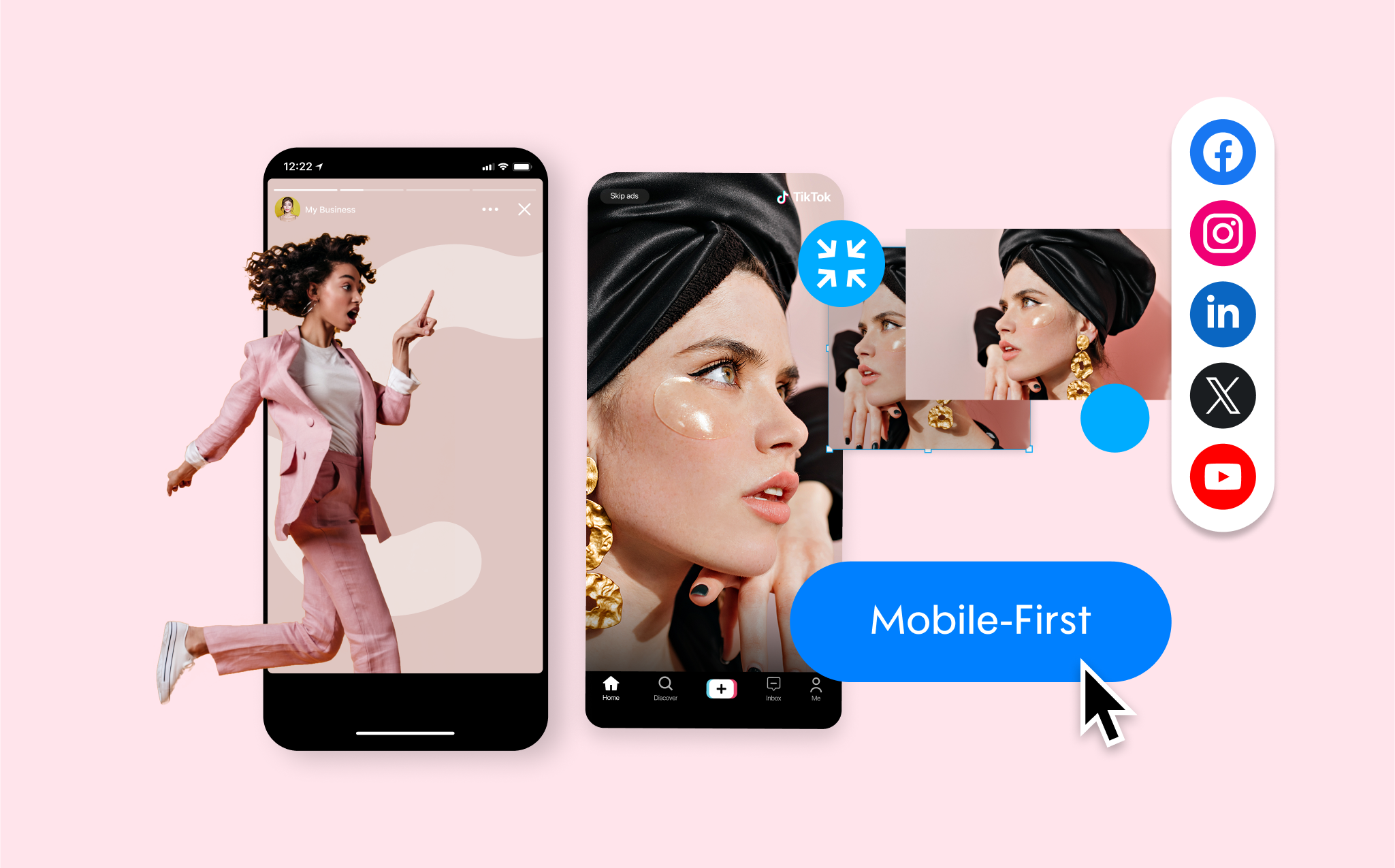
Mobile-First Video Marketing: How Small Businesses Can Capture Attention on the Go
- Blog
- Video Marketing
- Mobile-First Video Marketing: How Small Businesses Can Capture Attention on the Go
The jury is in: mobile devices are dominating the digital world. Consumers increasingly prefer to engage with content on their smartphones, making it essential for businesses to create videos that align with mobile viewing habits. Those that prioritize mobile-first video marketing will stay ahead of the competition and connect with audiences where they spend the most time.
Mobile-first video marketing focuses on optimizing content for smartphones by considering factors such as shorter attention spans, vertical viewing formats, and platform-specific behaviors. This approach helps businesses deliver impactful messaging that resonates with viewers and encourages action.
Shifting to mobile-first strategies pays off: mobile-optimized ads are 27% more likely to drive brand lift compared to traditional formats. With engagement rates soaring on mobile platforms, embracing this approach can boost your business’s visibility, increase conversions, and build stronger connections with your audience.
So, let’s do a deep dive into this increasingly essential topic, covering what it is, how to do it, and more.
What Is Mobile-First Video Marketing?
The shift toward mobile consumption is undeniable. Mobile devices now account for 64.25% of global internet traffic, underscoring the importance of reaching audiences where they are most active. Mobile users also tend to have shorter attention spans, meaning brands have just a few seconds to capture interest and inspire action. By adopting a mobile-first approach, businesses can create more engaging, accessible, and conversion-friendly video content that aligns with the fast-paced habits of modern consumers.
So, what is mobile-first video marketing? It’s the strategic approach of designing video content specifically for mobile devices, ensuring an optimal viewing experience on smaller screens. This approach prioritizes key factors such as aspect ratios, concise messaging, and user-friendly features that align with how people consume content on their phones. Unlike traditional video marketing, which often repurposes content meant for desktop or TV, mobile-first video marketing is built with mobile users in mind from the start.
Creating content that resonates with mobile audiences requires a unique set of considerations, including:
- Optimized Aspect Ratios: Vertical (9:16) and square (1:1) formats take up more screen real estate, making videos more visually engaging and easy to consume without rotating the device.
- Bite-Sized Content: Shorter videos, typically under 120 seconds, cater to mobile users’ fast-scrolling habits and shorter attention spans.
- Silent Viewing Compatibility: With a large portion of mobile content consumed without sound, adding captions and on-screen text ensures the message gets across effectively.
- Touch-Friendly Interactivity: Clickable elements and interactive features make it easier for users to engage with the content instantly.
Why Mobile-First Video Marketing Is Essential
Consumers expect brands to deliver content that fits seamlessly into their mobile experience—quick, engaging, and easily accessible. Businesses can no longer afford to overlook mobile-first video marketing. Here are a few reasons why. Here’s why.
Meeting Consumer Expectations
Consumer behavior has shifted dramatically toward mobile platforms, with vertical video and short-form content taking center stage on platforms like TikTok, Instagram Reels, and YouTube Shorts. Users are now accustomed to scrolling through endless streams of content and expect videos that are optimized for their preferred viewing experience. The rise of vertical video reflects how people naturally hold their phones, and businesses that embrace this format can ensure their content appears natively within users’ feeds.
75% of mobile users watch videos with the sound off, emphasizing the need for captions and visual storytelling. On Facebook, 85% of videos are viewed silently, demonstrating that brands must capture attention without relying on audio. Businesses that align with these trends by producing silent-friendly, visually engaging content are more likely to stand out, stay relevant, and retain viewer interest.
Enhanced Engagement and Conversions
Mobile-first videos not only capture attention but also drive meaningful engagement and conversions. Optimized content that loads quickly, offers immediate value, and provides clear calls to action can significantly impact user behavior. Mobile users are more likely to engage with content that is snackable and easy to digest, leading to increased video watch times, click-through rates, and ultimately, purchases.
A strong example of mobile-first success is Land Rover’s campaign, which achieved tens of millions of impressions by tailoring their video content specifically for mobile audiences. By utilizing vertical formats and focusing on concise, visually striking storytelling, Land Rover was able to create an immersive experience that resonated with mobile users. The campaign’s success illustrates how adapting content to fit mobile screens can amplify reach and drive impressive engagement metrics.
Best Practices for Mobile-First Video Marketing
To maximize the impact of mobile-first video marketing, businesses must adopt strategies that align with mobile user behavior and platform-specific requirements. Here are some best practices to follow.
Optimize Formats and Design
Choosing the right format is critical for ensuring an optimal viewing experience on mobile devices. Vertical (9:16) and square (1:1) formats are best suited for platforms like TikTok, Instagram, and Facebook, as they occupy more screen space and provide an immersive viewing experience.
Bright visuals, bold text, and high-contrast colors help capture attention quickly and ensure clarity, even in fast-paced scrolling environments. Additionally, using large, legible fonts and minimal clutter can improve readability and ensure that key messages stand out. With mobile screens being smaller, every design element should be intentional and contribute to a visually compelling story.
Keep It Short and Focused
Mobile users have short attention spans, making it crucial to capture their interest within the first three seconds. Whether it’s an eye-catching visual, an intriguing hook, or a compelling value proposition, the opening moments of a video should immediately engage viewers. On social media platforms, videos under 15-60 seconds perform best, as they align with how users consume content in bite-sized chunks.
Keeping videos concise and focused ensures that the core message is delivered effectively without losing viewer interest. Avoid overloading videos with excessive information—focus on one clear takeaway to keep the audience engaged and drive conversions.
Ensure Accessibility
Accessibility is a key factor in mobile-first video marketing, as a significant percentage of mobile users watch videos without sound. Including captions or subtitles ensures that the message is effectively communicated, even in silent mode. Additionally, using visual storytelling elements like animations, on-screen text, and clear imagery can enhance comprehension without relying on audio.
Responsive design is also essential—videos should be optimized to play seamlessly across various devices, screen sizes, and orientations without compromising quality or loading times. Ensuring accessibility not only broadens audience reach but also enhances user experience and engagement.
Incorporate Strong CTAs
A well-placed call-to-action (CTA) is essential for driving conversions and guiding viewers to the next step. Whether it’s “Shop Now,” “Sign Up,” or “Learn More,” clear and actionable prompts should be integrated naturally within the video content. CTAs should be visually distinct, strategically placed, and aligned with the video’s objective.
For example, including a clickable CTA within the first few seconds of a social media ad can capture impulse-driven viewers, while a strong closing CTA can reinforce the message and encourage action. Testing different CTA placements and wording can help optimize performance and increase engagement.
Use Platform-Specific Strategies
Each social media platform has unique features and audience expectations, making it important to tailor video content accordingly:
- On TikTok, brands should focus on trending challenges, catchy soundtracks, and fast-paced edits to blend naturally with user-generated content.
- Instagram Stories thrive on ephemeral content, so brands should leverage interactive features like polls, stickers, and swipe-up links to encourage engagement.
- YouTube, being a search-driven platform, requires optimized titles, descriptions, and tags to ensure discoverability and reach.
By understanding the nuances of each platform and adapting content accordingly, businesses can maximize their video marketing success across different channels.
How PromoAI Simplifies Mobile-First Video Marketing
Creating mobile-optimized video content can be challenging for small and medium-sized businesses due to resource constraints and the technical complexities involved. PromoAI simplifies the process with its AI-powered tools, making mobile-first video marketing more accessible, cost-effective, and scalable.
- AI-Driven Video Creation: PromoAI lets you pre-select your preferred aspect ratio to automatically generate a batch of videos in the chosen format. Videos automatically include captions and translations, making them more accessible to global audiences and catering to the 75% of mobile users who watch videos with the sound off.
- Affordable for Small Businesses: Traditional video production often requires significant investment in equipment, personnel, and editing software. PromoAI eliminates these high costs by offering an affordable, subscription-based model.
- Customizable and Scalable: PromoAI empowers small businesses with flexibility and scalability, ensuring their video content aligns with various campaign goals and audience segments. Whether creating a single promotional video or launching a full-scale marketing campaign, PromoAI provides the tools needed to scale efforts without sacrificing quality.
Overcoming Challenges in Mobile Video Marketing
Despite its potential, mobile-first video marketing comes with challenges that small businesses must navigate to maximize their success.
Cost and Resources
Producing high-quality videos that perform well on mobile can be expensive, often requiring professional equipment, skilled personnel, and advanced editing software. For businesses with limited budgets, this can pose a significant challenge.
Technical Constraints
Mobile video marketing requires an understanding of technical aspects such as file sizes, resolutions, and platform-specific requirements. High-resolution videos can slow down load times and deter viewers, while low-quality videos may fail to capture attention. Investing in video compression tools and optimization software helps businesses strike the right balance between quality and file size, ensuring smooth playback across devices without compromising visual appeal.
Capturing Attention
With users scrolling through endless content, grabbing attention within the first few seconds is critical. Mobile viewers expect fast, visually stimulating content that resonates instantly. Businesses can overcome this challenge by starting with bold visuals, compelling text overlays, and dynamic storytelling that hooks the audience right away. Strong, eye-catching thumbnails and concise messaging further help to draw viewers in. Focusing on relatable narratives and showcasing products or services in action can create an emotional connection, increasing the likelihood of engagement and conversion.
Actionable Tips for Small and Medium-Sized Businesses
Implementing a successful mobile-first video marketing strategy requires thoughtful planning and continuous improvement. Here are some actionable tips that small businesses can use to create engaging, effective content tailored for mobile audiences.
Plan for Vertical Formats
Mobile users primarily engage with content in a vertical orientation, making it crucial to shoot and design videos with this format in mind. Opting for vertical (9:16) or square (1:1) aspect ratios ensures that your videos fit seamlessly on platforms like Instagram Stories, TikTok, and Facebook Reels. Vertical videos not only enhance user experience but also increase visibility and engagement by occupying more screen space. When planning your shots, consider framing key elements centrally to ensure they remain visible across different devices and platforms.
Use Data-Driven Insights
Understanding your audience’s behavior is key to creating content that resonates. Analyzing data from social media analytics, website traffic, and video engagement metrics helps identify what type of content performs best. Insights such as watch time, click-through rates, and drop-off points can guide content adjustments to better align with audience preferences. By leveraging these insights, you can refine your messaging, optimize video lengths, and adjust publishing schedules to maximize impact.
Leverage Automation
Creating high-quality mobile-first videos doesn’t have to be time-consuming or costly. Automation tools like PromoAI simplify video production by offering pre-set templates, AI-generated voiceovers, and automatic captioning. These tools enable businesses to produce professional-looking content without needing a dedicated production team, helping to save both time and resources. Additionally, automated editing features ensure videos are optimized for different platforms, improving their performance and reach.
Experiment and Iterate
Success in mobile-first video marketing comes from continuous experimentation and learning. Testing different video styles, lengths, and call-to-action (CTA) placements allows you to determine what resonates most with your audience. A/B testing various elements—such as storytelling techniques, music choices, and visual styles—can provide valuable insights into viewer preferences. By iterating based on performance data, businesses can fine-tune their strategy and create content that consistently drives engagement and conversions.
Embrace Mobile-First Marketing for Business Growth
Mobile-first video marketing is a necessity for small businesses looking to compete in a mobile-driven digital landscape. By creating visually compelling, short-form, and accessible videos, you can enhance engagement, increase conversions, and build stronger customer relationships.
Ready to transform your video marketing strategy? Try PromoAI today to create high-impact, mobile-optimized videos that captivate your audience and drive conversions. Whether you’re looking to boost social media engagement, showcase products effectively, or streamline content creation, PromoAI makes it easy and affordable to stay ahead in the competitive digital marketplace.
Meet PromoAI
Generate a month worth of video content for your business in just one click!
About the author
Yariv Azatchi
You may also enjoy

October 29, 2024 · 10 min read

